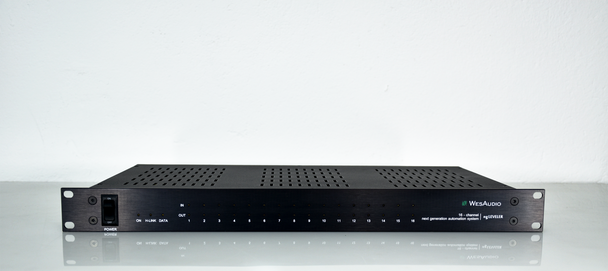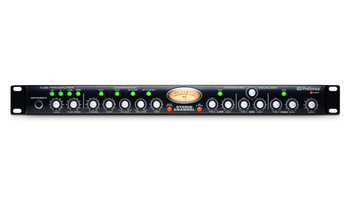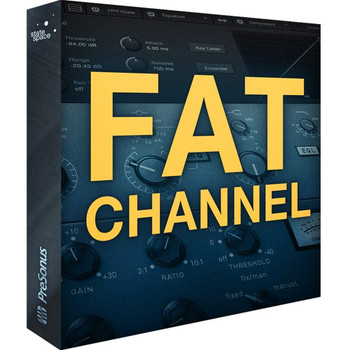Description
ngLEVELER
“Next generation Leveler” is analog automation system with convenient features for better studio integration. Besides its automation engine it also brings analog saturation per each channel which helps tracks to get more presence in the mix. ngLEVELER doesn’t have any controls, it is either managable via:
- DAW Plug-in
- HUI controller
Or both.
This approach gives us very convenient fader control with true total recall system via DAW plug-in. ngLEVELER was created to become studio centerpiece, and because of its simple analog connectivity it can be used in many applications!
MAIN FEATURES
Dedicated plugin control allows to recall and automate your analog signals with ease!
- 1. Opposite quad channel link: This functionality links two stereo channels in an opposite way, it means that by pushing level of channel 1 & 2, channel 3 & 4 signal will be lowered by the same amount, perfect solution to drive our stereo analog units maintaining the same signal level.
- 2. Channel mode: This parameter defines how two neighbor channels will be linked. There are following options:
- a. Off – No linking, pure dual-mono operation.
- b. Stereo – Channels will share exactly the same settings (absolute linking).
- c. Linked – Channels are linked relatively (relative linking) – perfect solution to compensate different channel levels while using dual mono analog devices as stereo pair.
- d. Linked Opposite – Channels are linked relatively (relative linking), but in opposite way, it means if channel 1 level will increase, channel 2 will be lowered by the same amount. It is perfect solution if we have mono unit that we would like to drive harder to hear how it performs. In that scenario ngLEVELER channel X OUT should go straight to IN of our device, and channel Y IN of ngLEVELER should receive signal from the OUT of device.
- 3. THD – toggles THD level, possible steps – OFF (LEDs disabled), MED, HIGH.
- 4. SOLO/MUTE – Solo and Mute for particular channel.
- 5. IN metering – signal level for particular channel measured after PAD, however before ngLEVELER main circuit (Leveling, THD, Solo, Mute).
- 6. Fader – Level control.
- 7. OUT metering – signal level for particular channel measured after ngLEVELER main circuit.
- 8. Channel name – assignable and fully user configurable channel name – please note that this name will be also communicated to external controller if in use.
- 9.Trim / Level value – depend on the mode (Fader/Trim) this field shows current value of: TRIM – When Fader mode is selected / LEVEL – When Trim mode is selected.
- 10. GROUP – Group asssigned to a particular channel.
- 11. PAD – Passive 6dB attenuator.
Monitoring!
- MUTE – channel is muted.
- SOLO – Any channel with solo active will pass the signal with full processing unless it is not explicitly muted. Hitting solo on particular channel will also mute all other channels unless solo or solo safe is not engaged.
- SOLO SAFE – Channel will pass the signal with full processing unless it is not explicitly muted – this channel will pass signal, even if other channels are soloed. Usually this approach is used to mark summed grouped signal to follow solo of individual tracks.
TRIM MODE!
Trim mode allows us to change level of each channel on top of already setup Faders. Trim faders also work in very high resolution as whole TRIM fader work in limited scale -10dB to +5dB. Such approach gives us few important benefits.
- With fader mode used as our main leveling mechanism, it is still possible to change the balance even if levels in fader mode are already automated. Let’s assume we would like to change level of the kick channel in already automated drums group.
- We can use group automation in fader mode, and still use Trim mode to either:
- Automate differently individual channels of our group,
- Or simply change level between individual tracks of our group.
- Trim mode also maybe very convenient for automation, as whole fader scale on the plug-in or controller is relatively small (15dB) compared to full scale of the fader mode.
CHANNEL GROUPS!
Assign each channel to one of 4 groups which
technically link all parameters in particular group.
Some parameters maybe disabled from groping:
- a) Level (Fader Mode level) / Trim (Trim mode level) / THD / PAD.
- b) This approach allows to automate for instance only LEVEL for whole group – keeping exactly same level relations between channels, and all other parameters (Trim/THD/Pad) can be used independently for each channel.
Each group can be also disabled at any time to allow modifications of each parameter for particular channel.
HUI Control!
ngLEVELER is fully compatible with HUI, that means most of its functions are manageable directly from HUI controller. To do so, it is enough to connect HUI controller to PC/MAC where ngLEVELER is available (so it is either connected to same machine via USB or when Ethernet connection is used, it is in the same network). Advantage of this approach is, that it is not necessary to run any application (DAW plugin) to control ngLEVELER from your HUI controller, it is enough to log into your operating system and you are good to go! There are few configuration options:
- HUI control surface to ngLEVELER – this function exclusively uses HUI controller to manage ngLEVELER parameters, in this mode HUI control surface can’t be used with DAW.
- HUI control surface to ngLEVELER with DAW mediation – this mode works exactly as above, with few differences
- All transport section, special functions are mediated to DAW,Fader section of HUI controller can be toggled via Function Key between: ngLEVELER control
- DAW control.
- ngLEVELER as HUI device – in this mode ngLEVELER acts as HUI controller, it means that it can be controlled by first 16 faders in your DAW session.
Convinient connectivity!
ANALOG: DB-25
DIGITAL CONTROL: USB or ETHERNET
THD – ADD COLOR TO YOUR MIXES on each channel!
THD stands for “Total harmonic distortion” and it allows to saturate your signal with beautiful analog color.
ANALOG AUTOMATION
I’m sure all of us wanted to use different device settings based on song section. Now it is possible! Just draw automation lines in your DAW and your analog device will follow!
And remember, you can use your HUI controller to record automation TO your DAW!
Usage examples:
1. Summing stage automation
ngLEVELER can be integrated in any spot in analog chain which requires signal level management or automation. One of such situation is level management or automation of signal which goes out from our outboard gear to the summing stage. This gives us few very important benefits:
POST Compression automation or level management – changing signal level which goes out from our converter (DAW automation) will cause our compressor to behave differently. This makes it impossible to automate, and is quite problematic situation to handle even with simple signal level balance changes. In this setup we can keep our summing stage signal level at same level, and leave automation and signal level management to ngLEVELER so it can be easily recalled upon session load!
OUT signal management and automation – all outboard gear have a sweet spot which usually depends on a signal level which comes in. In most cases we don’t want to automate signal going in, but signal which goes out from the device. With ngLEVELER we can easily manage this signal:
not to clip next analog stage,
Or automate it when needed!
2. Any analog outboard automation
In this particular example, ngLEVELER is integrated between each analog outboard process input, and output, of course it can be configured only to output, or only to input if needed. ngLEVELER allows us to work with very hot signals where many audio interfaces can’t deal with. Benefits:
Precise level management of signal going IN and OUT,
High level signal support of outboard OUT signal (ngLEVELER +24dBU and 6dB PAD) allows us to properly tune signal going in to our A/D converter.
3. Analog outboard drive
In this scenario we can configure our stereo processing before and after outboard gear, and link those channels in an opposite way. So while increasing level on the input of our outboard processor, it will automatically decrease on its output before hitting further stage. So we can easily find a sweet spot of our processor which can be fairly high for some vintage gear.
4. Recording session management
Studios of each size need some centerpiece which will help to manage recording and mixing session. Using ngLeveler in such situations, allows to precisely set levels which will hit A/D converter, add some analog saturation, and using “Solo and Mute” buttons manage our sessions with ease. Benefits:
- Signal level management going IN to A/D converter, with ngLEVELER 6dB PAD and +24dBu of headroom, it is very easy to support very hot signals coming from our microphone preamplifiers.
- Each session level signals can be easily recall upon session load!
Main features summary
- 16 channels of analog automation with total recall
- +25dBu(IN) / +28dBu(OUT) of headroom
- 6dB passive attenuator (PAD) for better integration with high level signals
- Very low noise and distortion – THD+N < 0.01%
- MUTE and SOLO for each channel
- HUI controller integration
- 16 channels of Proprietary THD
- IN and OUT (before and after signal leveling) metering fully integrated with DAW plug-in
- Flexible DAW/Live plug-in control for instant recall
- DB-25 analog connectivity
- Management via Ethernet or USB
- Fully digitally controlled and isolated analog circuit,
- Full automation record via HUI
- Free software and firmware upgrades












